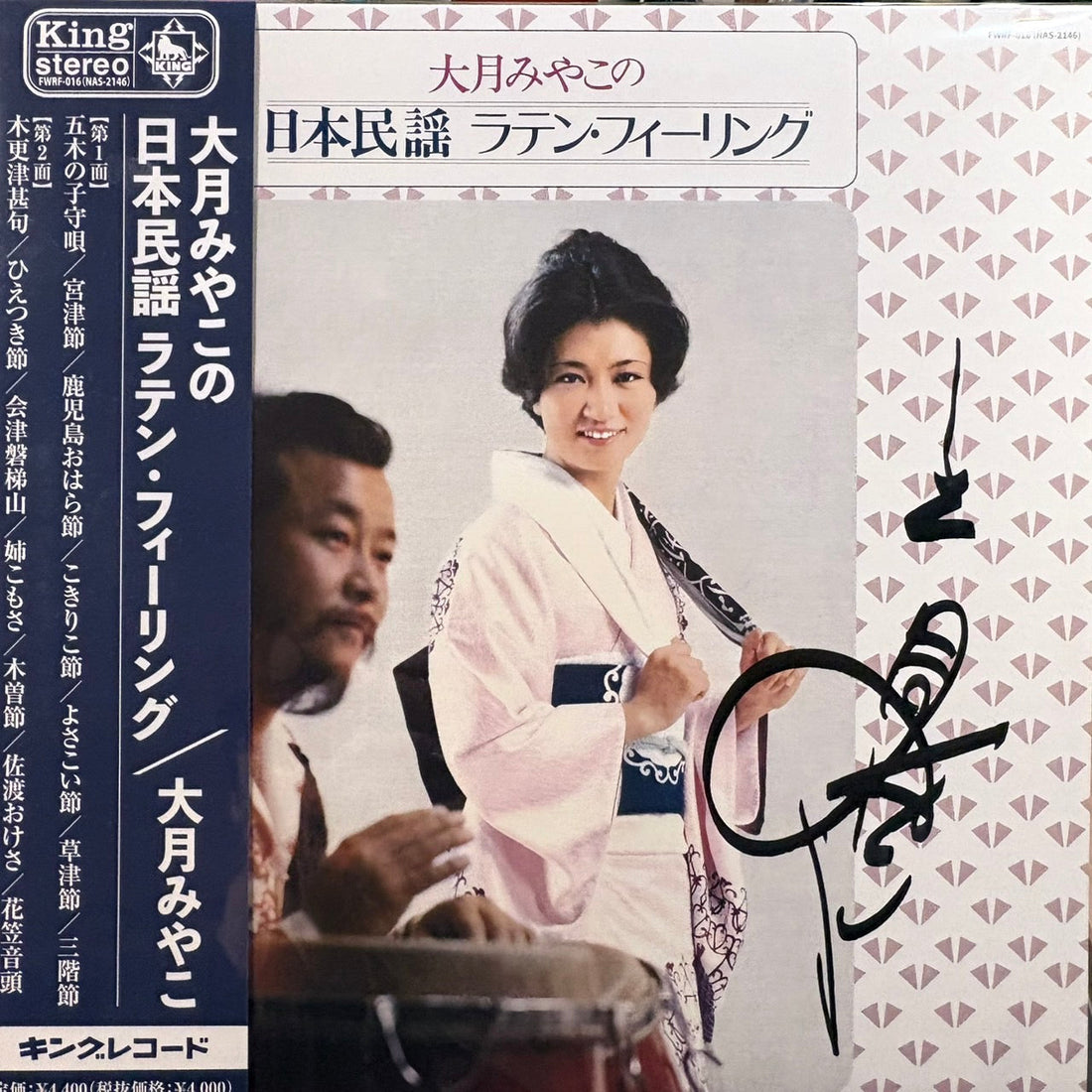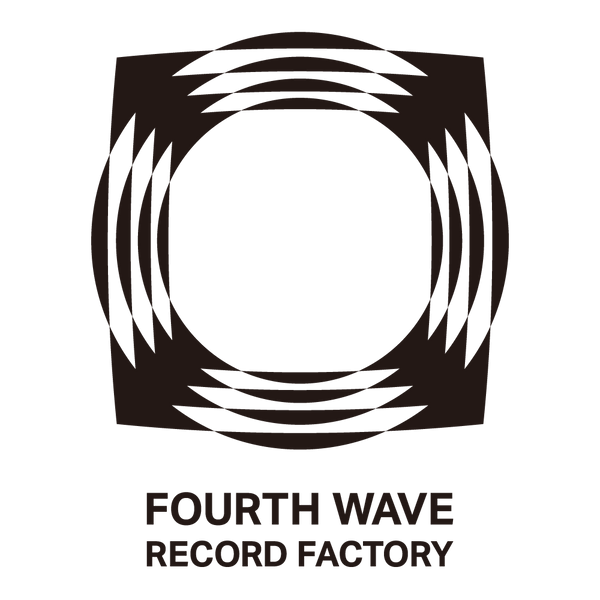
『Miyako Otsuki's Japanese Folk Song Latin Feeling』Vinyl Reissue Commemorative Interview (Part 2)
▪️"Miyako Otsuki's Japanese Folk Latin Feeling" Vinyl Reissue Commemorative Interview (Part 2)
A precious reissue commemorative interview about "Miyako Otsuki's Japanese Folk Latin Feeling," covering stories from that time and her experiences as a singer, part 2!! Please enjoy it thoroughly. (FWRF)

*Autograph received from the artist herself!!
There were simply very few instruments that could carry a tune.
—Besides Mr. Seno, were there any musicians who left a strong impression on you?
As you heard, there were very few instruments that could carry a tune; I think it was mostly just piano and flute. Some songs had 12-string guitar, but overall, there were very few instruments that could carry a tune. So at first, they asked me to use the piano to play a guide tone, and that’s how we set the key.
Then the flute and piano players would say, "This, this, this, just remember this part," and then I would start singing. So everyone worked hard to teach me the timing and how to sing.
The top-notch people at that time supported me, and I think I was the most inexperienced.
—Your singing ability doesn’t make it seem that way (laughs).
Record Company STAFF: You can’t normally sing with that kind of backing.
Miyako Otsuki: I praised myself when I managed it (laughs).
—Mr. Akira Miyazawa participated on flute; that’s an amazing lineup.
Yes, the backing musicians were really enjoying themselves. But I was the only one struggling (laughs).
I kept saying I can’t sing, I can’t sing...
Everyone: (burst out laughing)
—So the guide track is really important when recording vocals, right?
Exactly. This work has a lot of rhythm. Usually, except for songs that modulate midway, when we sing, the key is fixed, so we generally know it. But starting with percussion is unconventional and makes it hard to find the pitch. In folk songs, for example, "Sado Okesa" has an intro section, but this had none at all. Still, they played very earnestly and made it comfortable for me to sing.
My impression is that the members created everything themselves.
—Hearing that makes me realize the importance of arrangement. Did you have any interactions with the arranger, Mr. Akira Komachi?
Mr. Komachi... didn’t say much (laughs).
Everyone: (burst out laughing)
Miyako Otsuki: Well, Mr. Komachi was a respectable arranger, but for this album, he left it to Mr. Seno and the band. He said, "Do whatever you like."
—He must have understood it was better to let them do what they wanted.
Yes. They decided things like shortening the intro to 4 or 6 bars between Mr. Komachi and the members. My impression is that the members created everything themselves.
—So you were in a position to ask if you got stuck?
Record Company STAFF: You mentioned earlier that only the number of bars was written down; probably the members were the same. There were no strict rules, just big agreements, and the rest was free. They went with an improvisational style.
Miyako Otsuki: That’s right. I still have the sheet music from that time, and it only says 4 or 6 bars.
I actively listened to American pop and jazz records.
—Wow, that sheet music is precious too. This album has Latin arrangements, but did you listen to Latin music back then? I think Latin music like Pérez Prado was popular at the time.
Of course I listened. I might have been a bit cheeky; in high school, I learned kayōkyoku (Japanese pop), but I actively listened to American pop and jazz records.
Record Company STAFF: Like Gil Austin?
Miyako Otsuki: Yes, tenor sax. I was a precocious high schooler. It wasn’t really Latin, but Engelbert Humperdinck and Tom Jones. I even went to Engelbert Humperdinck’s concerts.
I was a kayōkyoku singer who wore kimono, but I liked going to see those concerts. Also Diana Ross. Maybe that’s why I liked the atmosphere of this work.
—So it connects more to Western pop than Latin!
There was no request to sing in a Latin style at all. I’m a kayōkyoku singer, so I suggested asking a folk singer, but they said, "A folk singer can’t sing it." I don’t mean to be disrespectful to folk singers, but they said, "Miyako-chan is the one we want."
I think the recording finished in 2 or 3 days.
—Roughly, how long was the production period for this album?
Less than a month. There are about a dozen songs. But I think the recording finished in 2 or 3 days.
—Amazing...
Record Company STAFF: That’s how live recording goes. That’s why it’s so full of groove.
〜Listening to the Kyoto folk song Miyazu-bushi from the tracklist〜
Miyako Otsuki: Why do you think I could sing this song?
—Hmm, I wonder?
I searched for the bass sound. Don, don, don—I just searched for that.
—Oh... it doesn’t sound like you were feeling your way at all. The quality is so high it’s astonishing. The groove is incredible.
It’s really good. I thought it was good when we finished. Maybe it was a bit too early for the times.
Record Company STAFF: It was 50 years ago...
Miyako Otsuki: I thought it was a shame, a shame, before I met the current producer and director, way before that.
I kept saying, "We did this, we did this, we did this, it’s definitely good. Listen, listen, listen."
Record Company STAFF: It was such an important album.
Miyako Otsuki: I was so troubled I thought about quitting singing. But I couldn’t say I couldn’t sing, so I stubbornly pushed through the recording.
I believe what the producer brought me was right.
—I think this album was made with mutual trust, and the musicians must have anticipated your genius singing ability and sense.
Well, at the time, I was so nervous I couldn’t see around me, but maybe they thought that, and later it gave me some confidence.
—I saw in a previous interview with Natalie that you said, "I try to give my all to any song I’m given," and "A singer expresses the given song in their own way." What did you focus on in your vocal expression for this work?
I have never once said I can’t do a given song, even if it’s not my genre. I don’t have any desire to sing a particular kind of song next. I believe what the producer brings me is right.
Even now at this age, I’ve never said I want to sing a certain kind of song next.
—I see, is it because you fully dedicate yourself as a professional singer?
Not exactly. In the past, I did an incredible amount of recording that’s unimaginable now. After touring the countryside, we’d cram recording into the few days back in Tokyo. Top kayōkyoku singers like Michiya Mihashi did the same. They’d do recording sessions rapidly.
Sometimes a new songwriter’s work would be like, "Okay, you try singing this." Even if it wasn’t made for me. I did a lot of recording.
I never had time to say I want to sing this kind of song, but I’m not that type of person anyway. So I’ve never said that.
—Is that just your original personality?
Record Company STAFF: I’ve been in charge of Ms. Otsuki for over ten years, and from the start, she said, "I’ll sing all the songs you bring me," and I feel every time that she sees how well she can sing and express the song as her challenge and pride as a singer, probably beyond what the director imagines.
Miyako Otsuki: You sound so arrogant (laughs).
Record Company STAFF: So I think she can hit wherever you throw the ball. Just throw it in the strike zone (laughs).
—Because there’s trust at the starting point, you sing properly because they select good songs, so you fully dedicate yourself as a singer within that trust.
I think the producers and people around me know my good points better than I do (laughs).
So I believe what those people say is never wrong.
—Mr. Seno also trusted each other in the same way, right?
Yes, there were 6 or 7 members including Mr. Seno, and they said, "Miyako-chan can sing," so I believed that.
—Knowing the production background you never imagined makes this album even more enjoyable.
It’s very well done.
—I first listened to this a few years ago and was really surprised by the quality. In fact, I think there aren’t many works that surpass this quality even now. Since top people gathered at that time, it was born because of that particular lineup, and it’s probably a once-in-a-lifetime world that’s very difficult to reproduce.
Thank you very much.
I asked for it to be made into a CD. I wanted to keep it too.
—This album was released on CD in 1997. Was it also because you wanted to spread it that it was made into a CD?
Yes. I asked for it to be made into a CD. I wanted to keep it too.
—That CD includes two additional songs not on the record. Do you know the background of that?
Record Company STAFF: When we looked into it, the added songs were also recorded in 1972. We don’t know why those two songs were left out and then added for the CD reissue. We checked the studio’s records from that time.
—Oh!
Record Company STAFF: It seems those two songs were initially on the list but were cut midway. We don’t know the exact reason, but probably because the A and B sides were limited to about 15 to 20 minutes for sound quality, and it might have gone over 20 minutes. Since this work is very particular about sound, someone probably said it can’t be longer than 20 minutes. That’s just speculation though...
—I see! That seems very likely. This reissue was a complete edition with those two songs added, but there’s another mystery: did the original release have an obi (paper strip)?
What? It did, right?
Record Company STAFF: No one knows (laughs).
—We actually asked selectors and record collectors and couldn’t find any copies with an obi. None appeared online either.
I still have one at home.
—If you have one at home, it might be the last copy. If it has an obi, I’d really like to see it.
Yes. I’ll check at home (laughs).
—It’s interesting that this remains a mystery (laughs).
There are still many things I want to ask, but time is almost up. Thank you very much for your precious time today.
Thank you very much as well.
(End)
*Akira Komachi: Composer and arranger (1931–2017). Active as an accordion player in Meiji University Mandolin Club. After graduation, worked as exclusive composer and arranger for King Records. Especially known for arrangements of many hit songs including Hachiro Kasuga’s "Yama no Tsuribashi" and "Bojo no Machi," Michiya Mihashi’s "Onna Sendou Uta," "Aishu Ressha," "Tassha de Na," Miko Otsu’s "Tokyo Anna," Hiroshi Sawa and TOKYO99’s "Ai no Fureai," and many others.
How did you find Miyako Otsuki’s precious stories from that time? If this interview made you curious about the music, please listen to the record below!!
FWRF-016 Miyako Otsuki Selected by MAGICTOUCH / Japanese Folk Latin Feeling (1LP W/OBI)
